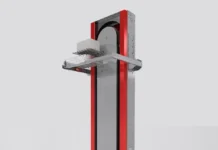Following the successful completion of a 15-month commercial technology validation of a polymer-based barrier replacing the aluminium layer, Tetra Pak is now moving to the next level of development – testing a fiber-based barrier that is a first within food carton packages distributed under ambient conditions.
This step marks yet another breakthrough in the company’s long-term roadmap towards developing an aseptic package that is fully renewable, fully recyclable and carbon-neutral.
The aluminium layer currently used in food carton packages plays a critical role in ensuring food safety; and even though it is thinner than a human hair, it contributes to a third of the green-house gas emissions linked to base materials used by Tetra Pak.
With a view to reducing this climate impact, a commercial technology validation was conducted in Japan starting late 2020, using a polymer-based barrier to replace the aluminium layer. This helped to understand the value chain implications of the change, and to quantify the carbon footprint reduction. It also confirmed adequate oxygen protection for vegetable juice, while enabling increased recycling rates in a country where recyclers favor aluminium-free cartons.
Incorporating these learnings, the company is now testing a new fiber-based barrier, in close collaboration with some of its customers. A first pilot batch of single serve packs featuring this industry-first material are currently on shelf for a commercial consumer test, with further technology validation scheduled later in 2022.
This initiative underscores Tetra Pak’s approach to design for recycling, where increasing the paper content is critical, and also supports end-user expectations. Based on recent global research 1 , approximately 40% of consumers confirmed they would be more motivated to sort for recycling, if packages were made entirely from paperboard and had no plastic or aluminium.
Gilles Tisserand, vice president Climate and Biodiversity, Tetra Pak, comments, “Early results suggest that the package with a fiber-based barrier will offer substantial CO2 reduction when compared to traditional aseptic cartons 2 , together with comparable shelf life and food protection properties 3 . We believe this development will therefore act as a breakthrough in reducing climate impact. In addition, cartons with higher paper content are also more attractive for paper mills; thus, this concept presents clear potential for realizing a low carbon circular economy for packaging.”
Eva Gustavsson, vice president Materials and Package, Tetra Pak adds, “Addressing complex issues such as climate change and circularity requires transformational innovation. This is why we collaborate not just with our customers and suppliers, but also with an ecosystem of start-ups, universities and tech companies, providing us access to cutting edge competences, technologies and manufacturing facilities.
“To keep the innovation engine running, we are investing Euro 100 million per year and will continue to do so over the next 5 to 10 years to further enhance the environmental profile of food cartons, including the research and development of packages that are made with a simplified material structure and increased renewable content. There is a long journey ahead of us, but with the support of our partners and a strong determination to achieve our sustainability and food safety ambitions, we are well on our way.”
Tetra Pak is a world leading food processing and packaging solutions company. Working closely with our customers and suppliers, we provide safe, innovative and environmentally sound products that each day meet the needs of hundreds of millions of people in more than 160 countries. With more than 25,000 employees around the world, we believe in responsible industry leadership and a sustainable approach to business.
1 Sustainable Packaging Consumer Research 2021, Tetra Pak’s latest environmental survey, run in summer 2021 and comprising a total of 12,000 consumer interviews based on an online questionnaire in 23 markets: Germany, France, UK, Italy, Saudi Arabia, Turkey, South Africa, China, India, Japan, Australia, Brazil, USA, Mexico, Chile, Poland, Sweden, Spain, Russia, Greece, Serbia, Dominican Republic, Argentina.
2 A one liter Tetra Pak carton package is typically made of approximately 70% paperboard, 25% of polyethylene and 5% of aluminium to protect the product inside.
3 For certain product categories, such as dairy products, the shelf life and food protection properties offered by the fiber-based barrier are comparable to aseptic carton packages that make use of aluminium.
IndiFoodBev — authentic, impactful and influential
An English-language food and beverage processing and packaging industry B2B platform in print and web, IndiFoodBev is in its third year of publication. It is said that the Indian food and beverage industries represent approximately US$ 900 billion in revenues which implies more than 20% of the country’s GDP. Eliminating the wastage on the farmside can help to deliver more protein to a higher number of the population apart from generating sizable exports. The savings in soil, seeds, water, fertilizer, energy and ultimately food and nutrition could be the most immense contribution that country is poised to make to the moderation of climate change.
To improve your marketing and grow sales to the food and beverage processing and packaging industry, talk to us. Our research and consulting company IppStar [www.ippstar.org] can assess your potential and addressable markets in light of the competition. We can discuss marketing, communication, and sales strategies for market entry and growth.
Suppliers and service providers with a strategy and budget for targeted marketing can discuss using our hybrid print, web, video, and social media channels to create brand recognition linked to market relevance. Our technical writers are ready to meet you and your customers for content.
The second largest producer of fruit and vegetables in the world is continuously expanding processing capacities and delivery systems with appropriate innovative technologies. We cover product and consumer trends, nutrition, processing, research, equipment and packaging from farm to thali. Get our 2025 media kit and recalibrate your role in this dynamic market. Enhance your visibility and relevance to existing markets and turn potential customers into conversations. Ask for a sample copy of our bi-monthly in print or our weekly IndiFoodBev eZine each Wednesday.
For editorial info@ippgroup.in — for advertisement ads1@ippgroup.in and for subscriptions subscription@ippgroup.in
Naresh Khanna – 10 February 2025
Subscribe Now











